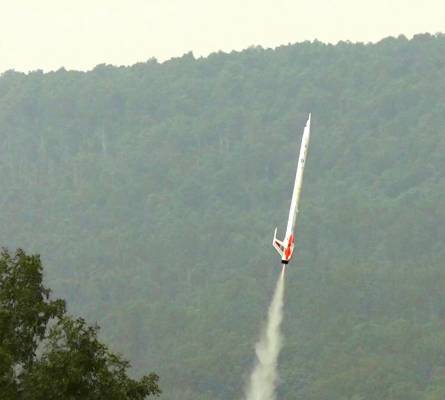The Interceptor: This rocket kit is the new release of the Estes Interceptor. It flies on 18mm B and C motors. This kit was modified with an ejection-gas baffle and Kevlar shock cord mount, and an Iris Altimeter Payload Section. After 6 months, it's finally ready. Construction went well, but painting using bargain-price Home Depot paint resulted in "orange peel" finish, which had to be sanded off - TWICE, and re-applied. The paint then reacted with the primer (SAME BRAND!!) and crinkled and cracked the finish. Re-sanded again and then used the expensive but acceptable Testors paint for $5 per 3 oz can. Clear-coat, decals, then 3 more clear-coats and finally it's done. With the generous glue, extra paint and the added electronics bay, she weighs in at 164.5 grams (5.6 oz.) and is 3.2" longer than stock. I'll plan to use the shorter ejection motors than recommended, just in case it's a little too heavy. Typically for me, this model only passed a string-stability test after I added 17 grams of nose-weight on the base of the nosecone. (Am I doing them wrong??) We'll see how well she flies, but she sure is a pretty gal!
We DID see how she flies, and it wasn't pretty. This model is grossly overweight. The baffle (10 grams?), payload section (19 grams), and the heavy nose-weight (17 grams) makes this too much for even a C6-3 motor. I'm going to send this up on a D10 just to see how well she can fly. Then I'm going to have to take out that nose-weight and see if it's stable enough for flight, I expect it to fly better that way. If it does not and it is destroyed, at least I'll have that one good D-flight to remember.
With the Apogee (Aerotek) D10 motor, this model has flown This rocket has flown higher than the St. Louis Gateway Arch, the Singer building in NY, NY, and the Chicago Temple Building.
I won't want to fly this on a regular basis using the $10 apogee motors though, so instead I hatched a plan to add two small A10-3T boosters on the back, for a total impulse with a C6 motor of 26. The parts for the "solid-rocket-boosters" were obtained from two Estes 220 Swift rockets. I'm waiting to see how well it will fly without the nose-weight before proceeding with this plan. It would be my first cluster rocket project.
| Flight Date: | 2013-08-31 |
| Rocket Name: | Interceptor |
| Kit Name: | Estes - Interceptor {Kit} (1250) [2008-2011,2019-] |
| Flyer's Name: | Rich DeAngelis |
| Motors: | C6-3 |
| Launch Site: | Fort Indiantown Gap, PA |
| Actual Altitude: | 180 Feet |
I wanted to test fly this again, just to prove the last successful flight was not a fluke. Again it had the noseweight removed (only added to pass a string-stability test).
After a good ignition, the Interceptor Iris left the pad accelerating at 4.9Gs. It burned for 2 seconds, averaging 1.2 Gs of boost. It reached a top speed of 53 mph (record for a C6 motor), and coasted upwards for another 2.3 seconds. This time it took a turn for about 20 degrees, then 30 or so, but continued up.
The ejection fired at a quick 2.3 seconds while at 163 feet, stopping the climb 1/10 second later at 168 feet, a very respectable altitude for such a heavy, draggy rocket. It then descended at a slightly faster 7 mph to land about 80 feet downwind, after a flight time of 18.1 seconds.
Unfortunately this time it missed the several acres of soft grass and found a spot of hard dirt, heavily cracking one of the wing pods on bounced landing. It can be fixed, but will never look as pretty. The performance is acceptable with a C6 motor, but not too impressive. Since this is going into the shop, I will install the twin 13mm A10 booster motors on this ship, to give it impressive takeoff performance. This will be my first parallel cluster motor rocket.
| Stage | Motor(s) |
|---|---|
| 1 | Estes C6-3 |
 |
 |



